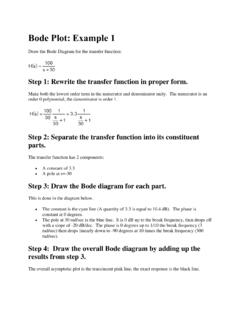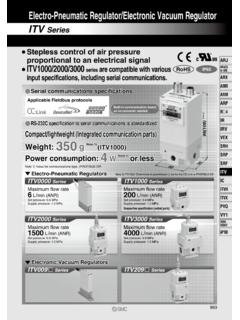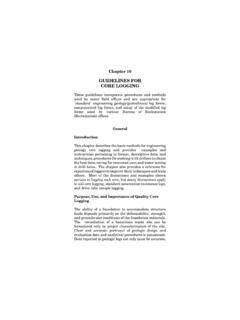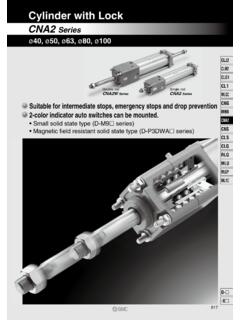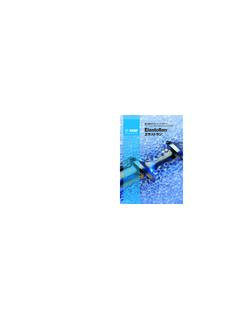Transcription of Chapter 7 TIMERS, COUNTERS and T/C APPLICATIONS
1 Ch 7 Timers, COUNTERS , T/C APPLICATIONS 1 Chapter 7 TIMERS, COUNTERS and T/C APPLICATIONS Introduction Timers and COUNTERS are discussed in the same Chapter since most rules apply to both. Timers and COUNTERS have been in existence for as long as relays and provide an important component in the development of logic. Timers were constructed in the past as an add-on device to relays slowing down the transition of the plunger from immediately opening or closing. The time delay was accomplished with a pneumatic bladder that allowed the air to escape either quickly or slowly depending on the setting of the timer.
2 Quick was usually less than a second and slow was usually between 30 and 60 seconds. Setting this kind of timer was an inexact science and today's traffic lights are an example of the fickle nature of timers that seldom respond in exactly the same from day to day and year to year. For the first time, function blocks are introduced in the rung output position or coil position to provide timer and counter functions. Function blocks allow inputs from the left and pass power through to the right when the function is done or when various conditions are met.
3 Either the timer has timed out or the counter has counted to the preset. Function block usage differs from manufacturer to manufacturer. Function blocks rely on a standard format to enter information about the counter or timer. All variables in the function block must be entered correctly before the device will operate. Some timers are referred to as retentive. Retentive refers to the device s ability to remember its exact status such that when the circuit is again activated, the timer continues from the previous point.
4 Non-retentive timers reset to zero and start from zero each time the timer function block is energized. Retentive is similar to blowing up a balloon. One does not blow a balloon up with one blast of air. It takes quite a few. The retentive balloon has a finger along the neck of the balloon holding the air already blown in captive. When more air is blown in, the new air is added to the air already present. Many processes in the factory rely on logic needing this kind of physical property to control a machine.
5 Other terms used in the timer and counter blocks are "preset" and "accumulated". These words refer to the preset or target amount and the "accumulated" amount that the timer or counter has built to get to a preset. Times are really counts stored as integer numbers. Thus, COUNTERS and timers are very similar. Timers increment a number regularly each time period (usually in increments of 1 msec.). Timers Timers are used to provide logic when a circuit turns on or off. Traditional pneumatic timers were provided as either on-delay timers or off-delay timers.
6 Contacts were provided both normally open and normally closed for each type of timer. The timer head was chosen as either the on-delay type or off-delay type. PLCs allow for a quick change from one type to the other with a few keystrokes on the programming panel. Symbols for Timers: Ch 7 Timers, COUNTERS , T/C APPLICATIONS 2 The following symbols are used for pneumatic timer contacts: On Delay (NOTC Normally Open Time Close)On Delay (NCTO Normally Closed Time Open)Off Delay (NOTO Normally Open Time Open)Off Delay (NCTC Normally Closed Time Close) Coils for pneumatic timers are drawn similar to relay coils except that TD is usually included in the label.
7 TD refers to time delay. Delay after Coil Energize contact closesOn Delay Coil(TD101)Delay after Coil Energize contact opensTimer StartsAcc = Pre Fig. 7-1 pneumatic On Delay Timer Symbols and Timing Diagrams Ch 7 Timers, COUNTERS , T/C APPLICATIONS 3 Delay after Coil De-Energize contact closesOff Delay Coil(TD102)Delay after Coil De-Energize contact opensTimer StartsAcc = PreFig. 7-2 pneumatic Delay Timer from Allen-BradleyFig. 7-3 pneumatic Off Delay Timer Symbols and Timing Diagram While these timers are only a sampling of the types of different timers, their function describes the main function of all timers, a time delay.
8 While PLC vendors do not need to use the terms of on-delay or off-delay, normally closed, normally open, held closed, or held open, these terms are an important part of design of PLC circuits. Some vendors still use the terms to show linkage between the PLC and the original timer circuits. Allen-Bradley provides three timers; TON, TOF, and RTO. All are block-type instructions and are located at the extreme right of each rung used. They are parallel to coils but may not be used in series with each other or in parallel with coils.
9 Each has two coils extending from its right. These coils are not programmed separately. These coils appear when the timer function block is programmed. Ch 7 Timers, COUNTERS , T/C APPLICATIONS 4 Siemens Timers First, we look at the Siemens Timer block and discuss the various types of timers available. Fig. 7-4a From Basic Instructions: Timer OperationsTimer Operations from Instruction ListTimer Operations from Help List TP: Generate pulse The instruction Generate pulse sets output Q for duration PT.
10 The instruction is started when the result of logic operation (RLO) at input IN changes from 0 to 1 (positive signal edge). The programmed time PT begins when the instruction starts. Output Q is set for the duration PT, regardless of the subsequent course of the input signal. Even if a new positive signal edge is detected, the signal state at the output Q is not affected as long as the PT time is running. Ch 7 Timers, COUNTERS , T/C APPLICATIONS 5 The current time value can be queried at the ET output (Elapsed Time).
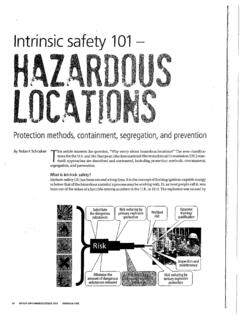
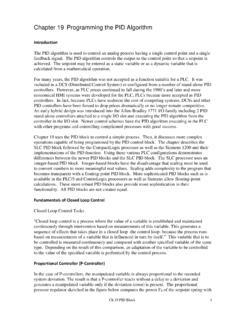
![CHAP. 7] BLOCK DIAGRAM ALGEBRA AND TRANSFER …](/cache/preview/5/5/8/8/1/3/4/c/thumb-5588134cce7b9b85f7cd5a0611a184e9.jpg)

